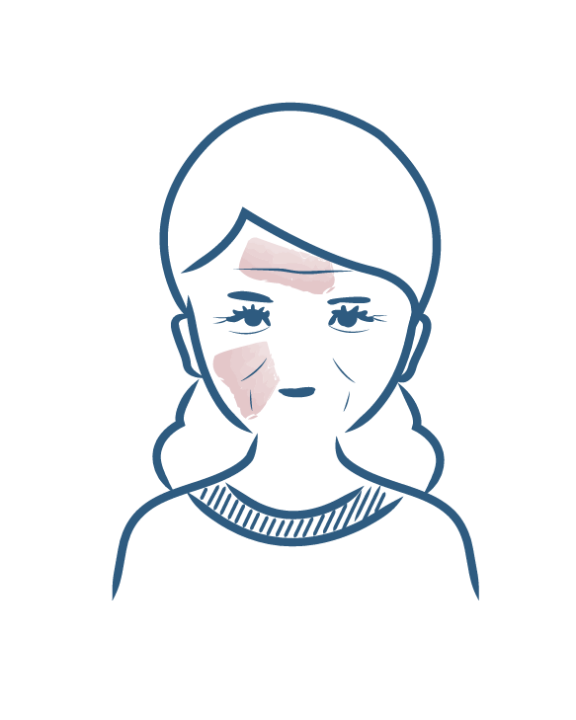
Brown spots on the skin
Hyperpigmentation is an uneven pigmentation of the skin that leads to the formation of brown spots. These marks on the skin are not painful, not contagious and are not associated with a serious disease. However, brown spots can pose an aesthetic problem for people who have them. Brown spots are stubborn and make the complexion uneven.
Who is affected by brown spots?
Absolutely anyone can be affected by the phenomenon of hyperpigmentation and the formation of pigmentation spots. Both fair skin and dark skin. Men and women alike. Whether young or old.
The one thing the different types of brown spots have in common is sun exposure. This is because the sun stimulates the activity of melanocytes, which are melanin-producing cells. Melanin is the biological pigment responsible for coloring the skin. When produced in large quantities, brown spots can appear. In some cases, these dark marks may simply disappear gradually, but they generally tend to remain over time.
What is chloasma?
Chloasma is a very common form of hyperpigmentation. Chloasma is characterized by the appearance of brown spots on the face: forehead, cheeks, nostrils and upper lip.
Chloasma results from a combination of sun exposure and female sex hormones. These promote melanocyte activity and melanin production, and consequently the formation of brown spots.
Pregnant women, women taking hormonal contraceptives and women on hormone replacement therapy are particularly affected by brown spots. In pregnant women, we call chloasma a “pregnancy mask”. In women taking contraception, chloasma may be called a “birth control mask”.
Chloasma is particularly common, since it affects 90% of pregnant women and one-third of women taking hormonal contraceptives(1). This marked skin affects the quality of life of many women and can have a significant impact on self-confidence. Fortunately, solutions exist to deal with brown spots.
What is lentigo?
Lentigo is another form of hyperpigmentation, linked to the phenomenon of skin aging rather than female sex hormones. Here too, sun exposure is an important contributing factor to the early development of brown spots, hence the term photo-aging.
Such brown spots are called lentigines, or age spots. These brown spots appear on areas exposed to the sun, such as the face, neck, décolleté, backs of the hands, forearms, shoulders and back.
Brown spots caused by skin aging usually appear from the age of 45, along with other signs of aging such as wrinkles and loss of skin firmness.
These different forms of hyperpigmentation affect 90% of women over the age of 50(2). Treatments exist for people with marked and hyperpigmented skin that can solve the problem of brown spots and also act on the different signs of aging.
What is hyperpigmentation of black and mixed skin?
Contrary to common belief, people with black or mixed skin also get brown spots and hyperpigmentation. In fact, dark skin is generally more likely to develop brown spots due to a higher amount of melanin. Hyperpigmentation on black and mixed skin can have several causes, not only sun exposure, which goes without saying, but also hormones (e.g. chloasma), aging (e.g. lentigo) and any type of skin inflammation. Even an eczema-type lesion or acne spot can lead to post-inflammatory hyperpigmentation. In other words, the lesion disappears but leaves a light or dark brown spot that may last for a varying period of time. People with black skin are more likely to be affected by the phenomenon of post-inflammatory hyperpigmentation. To limit its impact, it is important to effectively manage any dermatological conditions likely to cause skin inflammation and to avoid fiddling with lesions.
Points to remember
Brown spots are a very common skin disorder and can occur in several clinical situations. These include chloasma, lentigo and hyperpigmentation of black and mixed skins. Identifying the type of brown spot can allow you to take preventive and curative measures adapted to your situation.
There are also hypopigmentation, such as vitiligo, which results in white spots on the skin of the face and body. They are subject to appropriate follow-up with a dermatologist.
(1) Tyler KH. Physiological skin changes during pregnancy. Clin Obstet Gynecol. 2015
(2) Brenner M, Hearing VJ. Modifying skin pigmentation – approaches through intrinsic biochemestry and exogenous agents. Drug Discov Today Dis Mech. 2008
Our care routines
Hyperpigmentation

